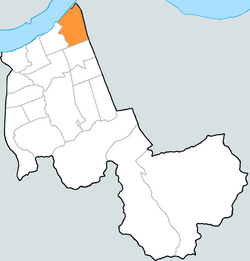Jamwon-dong | |
|---|---|
| Korean transcription(s) | |
| • Hangul | 잠원동 |
| • Hanja | 蠶院洞 |
| • Revised Romanization | Jamwon-dong |
| • McCune–Reischauer | Chamwŏn-dong |
 Jamwon-dong Community Service Center | |
 Jamwon-dong within Seocho-gu | |
| Country | South Korea |
| Area | |
| • Total | 1.95 km2 (0.75 sq mi) |
| Population (2012) | |
| • Total | 37,368 |
| • Density | 19,000/km2 (50,000/sq mi) |
Jamwon-dong is a dong, neighbourhood of the greater Gangnam area Seocho-gu in Seoul, South Korea.[1][2] Until 1988, Jamwon-dong was under the jurisdiction of Gangnam-gu. Jamwon-dong is popular for its mulberry trees and silkworms, whose cocoon is used to make fabric for clothing. As a legal-status neighborhood, Jamwon-dong includes Banpo 3-dong and Jamwon-dong (administrative neighborhood).
Education
[edit]- Middle Schools
- Shindong Middle School
- Kyongwon Middle School
- Elementary Schools
- Sindong Elementary School
- Banwon Elementary School
Transportation
[edit]- Jamwon station of

- Sinsa station of

- Banpo station of

- Nonhyeon station of

- Express Bus Terminal station of

See also
[edit]References
[edit]- ^ "잠원동 (Jamwon-dong 蠶院洞)" (in Korean). Doosan Encyclopedia. Retrieved 2008-04-19.[permanent dead link]
- ^ "The origin of Jamwon-dong" (in Korean). Seocho-gu official site. Archived from the original on 2015-04-03. Retrieved 2008-04-19.
External links
[edit]- Seocho-gu official website
- Seocho-gu map at the Seocho-gu official website
- (in Korean) The Jamwon-dong Resident office

Well, that’s interesting to know that Psilotum nudum are known as whisk ferns. Psilotum nudum is the commoner species of the two. While the P. flaccidum is a rare species and is found in the tropical islands. Both the species are usually epiphytic in habit and grow upon tree ferns. These species may also be terrestrial and grow in humus or in the crevices of the rocks.
View the detailed Guide of Psilotum nudum: Detailed Study Of Psilotum Nudum (Whisk Fern), Classification, Anatomy, Reproduction